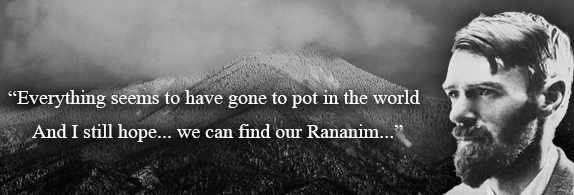Why We Love New Mexico – D.H. Lawrence and Rananim by V.B. Price/ New Mexico Mercury
August 19, 2014

One of the many reasons we love New Mexico so much is that although we are an economically troubled state we try to make the most of what we have.
A good example of this is the old Kiowa Ranch outside of Taos, now known as the D.H. Lawrence Ranch, bequeathed to the University of New Mexico by Lawrence’s wife Frieda upon her death in 1956. Those 160 acres of high mountain meadow land are where the British writer and world wanderer D.H. Lawrence spent the better part of two years, from l922 to l925, nursing his tuberculosis, and writing one of his most important novels, The Plumed Serpent.
The Ranch has been in disrepair for a number of years, but now UNM and many volunteers are working to return it to its proper function as a writer’s and thinker’s retreat. And one way the university is working to do this is by creating an online writing community called Rananim as part of UNM’s Taos Summer Writing Program. It is hoped Rananim will create a revenue stream that can be used to help renovate the ranch and its many buildings and the D.H. Lawrence Shrine where the writer’s ashes are interred.
Rananim is a fascinating word that opens up many of the philosophical and spiritual ideas of Lawrence in his avatar as critic of modern, mechanized, industrial civilization, a world, in the words of the Hopi and of filmmaker Godfrey Reggio, that is a Koyaanisqatsi, a world out of balance. Lawrence had visited the Hopi Village of Hotevilla on Third Mesa in l924 and witnessed a snake dance there. The word Rananim refers to a utopian community of like-minded people seeking the deepest levels of authenticity. Lawrence conceived the idea on a Christmas Eve during the early years of World War I, possibly 1914.
It is thought Lawrence adapted the word from the Hebrew word for “rejoice” or “make cries of joy” for the blessings of life found in the first book of the 33rd Psalm. It implies that such a community would be grounded in joyful praise and that praise, through the support of a community of people aspiring to the best in themselves, would constitute right living. The word supports Lawrence’s vision of himself as a religious writer, though he was roundly criticized for the sexual explicitness in scenes in his novels, even to the point of being accused of writing pornography.
Lawrence sought locations for Rananim in Florida, perhaps southern France, and in New Mexico as a prophetic ideal, I think, rather than an actuality. But the idea lingers, and is a worthy symbol for a writerly project to aid in the restoration of the Lawrence Ranch and shrine.
Lawrence died of tuberculosis in l930. E.M Forster, the great English novelist, wrote in an obituary that Lawrence was “the greatest imaginative novelist of our generation.”
For me, Lawrence’s friendship with Aldous Huxley, the author of Brave New World, published two years after Lawrence’s death, helps me see past Lawrence’s shallow, even idiotic and dangerous, authoritarian political views, and allows me to focus on his spiritual emphasis on self-actualization, peak experiences of authenticity in loving relationships, and the majesty and evocative power of his prose.
What has always turned me to Lawrence is his love of New Mexico and his realization that the Great God Pan, the ancient Greek god of the wild, was still somehow a force of rejuvenation in this hot and crumbling world of ours.
As he said once in a 1936 essay in New Mexico Magazine, “I think New Mexico was the greatest experience from the outside world that I have ever had! It certainly changed me forever.” Many of us could say the same for ourselves.
The best way to start to get to know Lawrence is to read his major novels, The Plumed Serpent, Sons and Lovers, Women in Love, and Lady Chatterley’s Lover. I also recommend shorter works such as St Mawr and The Man Who Died.
A good introduction to the spiritual and literary aura that surrounds Lawrence is to read The Glyph and the Gramophone: D.H. Lawrence’s Religion, by Luke Ferretter, published by New Directions, 2013.
